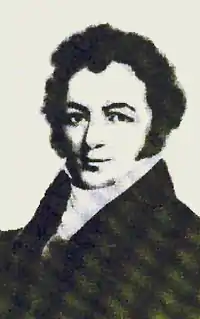Samuel Price Carson
Samuel Price Carson (January 22, 1798 – November 2, 1838) was an American political leader and farmer in both North Carolina and Texas. He served as U.S. congressional representative from North Carolina. At the time of his death in 1838, he owned 44 slaves.[1]
Samuel Carson | |
|---|---|
 | |
| Secretary of State of Texas | |
Acting | |
| In office March 18, 1836 – April 29, 1836 | |
| President | David G. Burnet |
| Preceded by | Position established |
| Succeeded by | Samuel Collinsworth |
| Member of the U.S. House of Representatives from North Carolina's 12th district | |
| In office March 4, 1825 – March 3, 1833 | |
| Preceded by | Robert B. Vance |
| Succeeded by | James Graham |
| Personal details | |
| Born | Samuel Price Carson January 22, 1798 McDowell County, North Carolina, U.S. |
| Died | November 2, 1838 (aged 40) Hot Springs, Arkansas, U.S. |
| Political party | National Republican |
North Carolina
He was born at Carson House, Pleasant Gardens, in what is now McDowell County, North Carolina, and studied under private tutors in Pleasant Gardens.
He engaged in agricultural pursuits and was a member of the North Carolina Senate 1822-1824. Carson was elected as a Jacksonian to the Nineteenth and to the three succeeding Congresses (March 4, 1825 – March 3, 1833), but lost re-election in 1833. He was then again elected to the state senate in 1834 and served as a delegate to the State constitutional convention in 1835.
Robert Brank Vance was mortally wounded by Samuel Price Carson, who challenged him to a duel, fought at Saluda Gap, North Carolina, because of a derogatory remark made during the 1827 campaign.[2]
Texas / Arkansas
By 1836, he had moved to Texas, and was elected by his neighbors to the Convention of 1836, where he signed both the Texas Declaration of Independence and the Constitution of the Republic of Texas. The convention also established an interim or acting government for the republic, which was still at war in rebellion against Mexico. They considered him for president, but elected David G. Burnet, instead, by six votes more than Carson received.[3] In a later vote they elected Carson the Secretary of State. President Burnet sent him to Washington, DC, to lead a team to negotiate for recognition of and aid for Texas, then later named James Collinsworth to replace him as secretary of state. When Carson learned of this from a newspaper, he simply went home.[4]
Later, when borders were formalized, Carson's home was identified as part of Miller County, Arkansas. He died in Hot Springs, Arkansas, and is buried in the Government Cemetery there.
References
- "FamilyTreeDNA - Genetic Testing for Ancestry, Family History & Genealogy". www.familytreedna.com. Retrieved 2023-07-11.
- Long, Kim (2008-12-18). The Almanac of Political Corruption, Scandals, and Dirty Politics. Random House Publishing Group. ISBN 978-0-307-48134-4.
- Louis Kemp; The Signers of the Texas Declaration of Independence; Salado, Texas; Anson Jones, 1944.
- The Handbook of Texas entry for Carson.